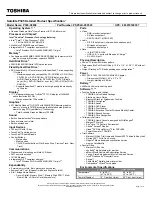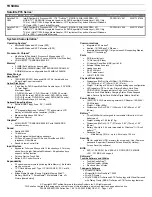
Side Views (1-8,9)
Bottom View (1-10,11)
AC Adapter (1-12)
LED Status Indicators (1-13)
Keyboard Features (1-14)
Function (Quick) Keys (1-14)
Windows Keys (1-15)
Embedded Numeric Keypad (1-15)
Touch Pad (1-16)
Graphic Subsystem (1-17)
Adjusting the Display Brightness (1-17)
Extending the Life of the TFT Display Panel (1-17)
Opening and Closing the Display Panel (1-18)
Audio Subsystem (1-19)
Adjusting the Volume in Windows (1-19)
Voice Recording (1-19)
Modem and Modem Setting (1-20)
Ethernet Adapter (1-21)
2. BIOS SETUP AND SECURITY
Entering the BIOS Setup Screen (2-3)
Leaving the BIOS Setup Screen (2-3)
BIOS Action Keys (2-3)
Modifying the BIOS Settings (2-4)
Main Setup (2-4)
Advance Setup (2-4,5)
Boot Setup (2-5,6)
Security Setup (2-7,8)
Power Setup (2-8,9)
Exit Setup (2-9)
3. BATTERY POWER & POWER MANAGEMENT
The Battery Pack (3-2)
Lithium-Ion Battery Technology (3-2)
Battery Low-Power Warning (3-3)
Installing and Removing the Battery Pack (3-4,5)
Charging the Battery and Charging Time (3-5)
Checking the Battery Level (3-6)
Prolonging the Battery’s Life and Usage Cycles (3-6)
Using Windows Power Options (3-7)
Windows’ Power Schemes (3-7,8)
Suspend Modes (3-9,10)
Power Button Action (3-11)
Low Battery Warning (3-12)
Power Manual Quick Access (3-13)
4. TROUBLE-SHOOTING2
First Step (5-2,3)
Audio Problems (5-4)
Hard Disk Problems (5-5,6)
Optical Drive Problems (5-7)




































